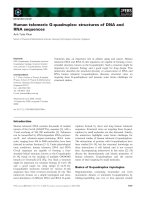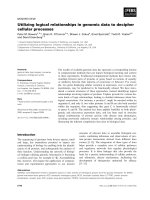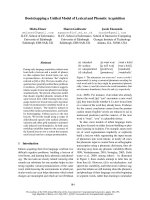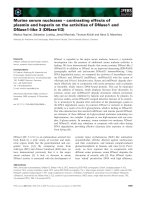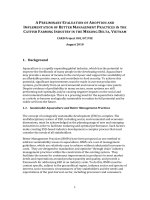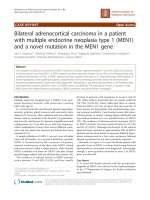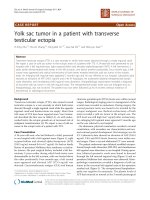báo cáo khoa học: "Patient Care Teams in treatment of diabetes and chronic heart failure in primary care: an observational networks study" pptx
Bạn đang xem bản rút gọn của tài liệu. Xem và tải ngay bản đầy đủ của tài liệu tại đây (678.14 KB, 9 trang )
RESEARC H Open Access
Patient Care Teams in treatment of diabetes
and chronic heart failure in primary care:
an observational networks study
Jan-Willem Weenink, Jan van Lieshout, Hans Peter Jung and Michel Wensing
*
Abstract
Background: Patient care teams have an important role in providing medical care to patients with chronic disease,
but insight into how to improve their performance is limited. Two potentially relevant determinants are the
presence of a central care provider with a coordinating role and an active role of the patient in the network of
care providers. In this study, we aimed to develop and test measures of these factors related to the network of
care providers of an individual patient.
Methods: We performed an observational study in patients with type 2 diabetes or chronic heart failure, who were
recruited from three primary care practi ces in The Netherlands. The study focused on medical treatment, advice on
physical activity, and disease monitoring. We used patient questionnaires and chart review to measure connections
between the patient and care providers, and a written survey among care providers to measure their connections.
Data on clinical performance were extracted from the medical records. We used network analysis to compute
degree centrali ty coefficients for the patient and to identify the most central health professional in each network.
A range of other network characteristics were computed including network centraliza tion, density, size, diversity of
disciplines, and overlap among activity-specific networks. Differences across the two chronic conditions and
associations with disease monitoring were explored.
Results: Approximately 50% of the invited patients participated. Participation rates of health profes sionals were
close to 100%. We identified 63 networks of 25 patients: 22 for medical treatment, 16 for physical exercise advice,
and 25 for disease monitoring. General practitioners (GPs) were the most central care providers for the three
clinical activities in both chronic conditions. The GP’s degree centrality coefficient varied substantially, and higher
scores seemed to be associated with receiving more comprehensive disease monitoring. The degree centrality
coefficient of patients also varied substantially but did not seem to be ass ociated with disease monitoring.
Conclusions: Our method can be used to measure connections between care providers of an individual patient,
and to examine the association between specific network parameters and healthcare received. Further research is
needed to refine the measurement method and to test the associatio n of specific network parameters with quality
and outcomes of healthcare.
Background
Chronic disease represents a significant challenge for
health systems, because it requires major changes in the
organization of healthcare and in the tasks of many health
professionals [1]. Structured clinical management of
chronic disease impro ves health outcomes and efficiency
of the healthcare delivery [2]. Providing chronic care has
increasingly be come the task of a patient care team,
rather than an individual health pro fessional [3], and
improved team functioning is expected to be associated
with better quality and outcomes o f healthcare delivery
[4,5]. Previous studies identified numerous factors of
team functioning associated with team performance in
healthcare, though evidence on perfo rmance of primary
care teams in treatment of chronic disease remains
ambiguous [5-7].
* Correspondence:
Scientific Institute for Quality of Healthcare, Radboud University Nijmegen
Medical Centre, P.O. Box 9101, 6500 HB, Nijmegen, the Netherlands
Weenink et al. Implementation Science 2011, 6:66
/>Implementation
Science
© 2011 Weenink et al; licensee BioMed Central Ltd. This is an Open Access article distributed under the terms of the Creative
Commons Attribution License (http://creative commons.org/licenses/by/2.0), which permits unrestricte d use, distribution, and
reproduction in any medium, provided the original work is proper ly cited.
It has been suggested that the presence of a central
car e provider in a team, who acts as a contact point for
both patient and other health professionals and takes
responsibility for the delegation of care to others on the
team, is crucial in achieving optimal outcomes [8,9].
This could optimize the coordination of healthcare
delivery and ensure that all necessary expertise and rele-
vant patient information is present to p rovide effective
clinical management. Patients who receive medical care
from a t eam of health professionals may benefit from a
wider range of skills. The inclusion of specific indivi-
duals, such as a nurse or pharmacist, may ensure that
specific elements are more evidence-based [3]. A few
field studies showed that the type and diversity of clini-
cal expertise involved was expected to account for
improvements in patient care and organizational effec-
tiveness [10,11]. Finally, sharing knowledge in patient
care teams could lead to shared practice routines and
better coordination of care.
A key aspect of chronic illness care is that it should
take a patient-centered focus, meaning that it i s respect-
ful of and responsive to individual patient preferences
and needs [12]. Ideally, it is characterized by productive
interactions between team and patient that consistently
provide the assessments, support for self-management,
optimization of therapy, and follow-up associated with
good outcomes, and these interactions are m ore likely
to be product ive if patients are active, informed partici-
pants in their care [8]. Previous studies have focused on
patient-perceived involvement [13] and communication
of teams to patients in g eneral [14]. Actual involvemen t
of individual patients in pr ocesses of healthcare delivery
was measured less frequently [15].
Network analysis is a quantitative methodology that
offers the opportunity to measure and analyze connec-
tions between health professionals in a patient care
team [16,17]. Pilot studies have examined the feasibilit y
and relevance of network analysis for studying patient
care teams in chronic illness care [18,19]. In these pilots,
interactions were measured in a generic way. However,
networks of health professionals differ across individual
patients, even if they have the same disease and same
primary care provider. Furthermore, the pa tient was not
included in the networks in these pilots. In addition,
associations between network characteristics and health-
care delivery were not yet examined in chronic illness
care. Thus, our aim was to measure information
exchange networks related to individual patients with a
chronic disease, including relevant health professionals
and the patient, and to relate network characterist ics to
aspects of healthcare received.
Our study focused on three specific aspects of health-
care for patients with type 2 diabetes or chronic heart
failure (CHF): medical treatment, physical exercise
advice, and monitoring. Previous research has shown
gaps between recommended practice and healthcare
received in these patients [2,20,21], suggesting a poten-
tial for improvement. The structure of the networks of
information flows between the patient and care provi-
ders, and among care providers, was expected to be par-
ticularly related to monitoring routines. Monitoring
demands an active role of the team [22]. Furthermore, it
requires a clear task distribution, knowledge on latest
guidelines, and convincement of its benefits. D espite
recommendations in prevailing practice guidelines, these
benefits remain a topic for continuing debate [23].
Therefore, we expected that social factors would be
associated with monitoring routines.
Three s pecific objectives were defined. A first objec-
tive was to test the feasibility of the sampling and mea-
surement procedures, because some previous network
studies did not f ully report on response rates [18,24]. A
second objective was to examine the variation of net-
work characteristics across individual patients, because
this would open the possibilit y that these characteristics
are related to relevant outcomes and across chronic
conditions. A final objectiv e was to explore asso ciations
between specific network characteristics and compre-
hensive monitoring in these patients, although the size
of our study was too small to draw f irm conclusions on
these associations.
Methods
Study design
An observational study was performed for which we
invited 30 patients with type 2 diabetes and 30 patients
with CHF from three primary care practices. In each
pract ice, we randomly selected 10 patients with diabetes
and 10 patients with CHF in the medical record system.
Patients with diabetes were selected using available data-
sets in the practices, patients with CHF were selected
with use of t he International Classification of Primary
Care(ICPC) code. If a patient was physically or mentally
incapable to participate, he or she wa s replaced b y the
next patient on the list. The ethical committee of Arn-
hem-Nijmegen waived approval for t his study. Patients,
general practitioners (GPs), practice nurses, and practice
assistants in the participating practices wer e asked to
complete a structured questionnaire. Written informed
consent was obtained for collecting data from the
patients’ medical record.
Measures
Patient questionnaire
Patient s were asked to report on the number of disease-
specific contacts they had had in the past 12 months
concerning medical treatment, physical exe rcise advice,
and disease monitoring, and what health professionals
Weenink et al. Implementation Science 2011, 6:66
/>Page 2 of 9
were involved in these contacts. Medical treatment was
defined to the participants as any contact related to dis-
ease-specific medication (e.g., dosage, application,
adverseeffects).Physicalexerciseadvicewasdefinedas
any contact related to physical exercise or its impor-
tance. Disease monitoring was defined as any contact
related to disease-specific blood monitoring. Health pro-
fessionals, both in general practice as outside the prac-
tice, were listed by discipline. Other questions
concerned general patient and disease characteristics.
Medical records
After patients’ written informed consent, we extracted
information from medical records concerning individual
characteristics and received monitoring. Parameters
included bodyweight, body mass index, blood pressure,
HbA1C (only for diabetes patients), glucose, serum crea-
tinine, potassium, sodium, and lipid values. Medication
for diabetes and cardiovascular conditions was also
extracted.
Care provider questionnaire
Health professionals in the practices were asked about
their role in diabetes and CHF care in general, and
about their collaboration with other health professionals
in medical treatment, physical exercise advice, and dis-
ease monitoring. For these three specific activities, they
were asked to report on patient-related contact with
other disciplines, both inside as outside their practice.
Health professionals were listed by discipline.
Data analysis
We used UCINET 6 for constructing networks and
obtaining network parameters, and SPSS 15 for all other
analyses. Response rates for both patients and health
professionals were d etermined. We determined reliabil-
ity of reported connections with other health profes-
sionals by examining the proportion of all possible
connections that were mutually reported present or
absent (called reciprocity coefficien ts in non-directed
networks).
Construction of networks and network parameters
For each patient, three activity-speci fic ego-centred net-
works were constructed, related to medical treatment,
physical exercise advice, and disease monitoring. An
activity-specific network was only constructed if the
patient reported at least one connection with a profes-
sional regarding the specific activity. A two-step proce-
dure was used to co nstruct these networks: first, patient
questionnaires and medical records were u sed to iden-
tify connections between the patient and health profes-
sionals; then care provider questionnaires were used to
identify connections between health professionals, defin-
ing a connection if either one or both of the health pro-
fessionals reported to be connected.
If a patient had contact with a health professional
within a general practice (e.g., GP), all health profes-
sionals in that pract ice were included in the constructed
network. If a health professional was involved in a n
act ivity-spe cific network (e.g., concerning medical treat-
ment), this professional was included in the other activ-
ity-specific networks of this patient as well.
If the response of a health professional was missing, it
was substituted by t he response of the other individuals
in the practice. We filled in a zero indicating no contact,
if both individuals did not provide information on their
connection. This method is commonly used in network
analysis [25], though its appropriateness for this specific
context has not been tested. A ‘ zero’ in the data files
therefore referred to absence of a connection, or
absence of data on presence of a connection.
Network parameters and hypotheses
We examined a number of specific network parameters,
which we hypothesised to be related to healthcare deliv-
ery and outcomes.
Size and diversity are the number of involved health
professionals and different disciplines. A high number of
involved health professionals could hinder coordination
of care for an individual patient. Multiple involved disci-
plines, however, could be beneficial because of the avail-
ability of a wider range of skills [5].
Density is the proportion of all possible connections in
a n etwork that are actually present. In a dense networ k,
information can flow quickly between most individuals.
It may also be associated with a number of cognitive
social processes, which result in positive intentions in
team members to use the information in daily practice.
This could contribute to more eviden ce-based and more
standardized practice patterns [26].
Network centralization is a measure that expresses to
what extent a network is organized around a single per-
son. It has been suggested that the presence of a central
care pro vider in chronic illness care is crucial to achieve
optimal outcomes [8].
The degree centrality coefficient is the proportion of
all possible connections that are actually present for an
individual. We computed degree centrality coefficients
for the patient and for the most central health profes-
sional. The discipline of the most central health profes-
sional was also noted. A high centrality of the health
professional can contribute to coordination of care
through connection with many other involved health
professionals. When this cen tral health professional is
one with high expertise (in a general practice usually a
GP), knowledge on the best possible care can flow
through the patient care team. Furthermore, initiatives
on improving healthcare more o ften focus on a central
role for the patient in its own care process [8]. We
Weenink et al. Implementation Science 2011, 6:66
/>Page 3 of 9
think active involvement of a patient will result in a
comprehensive monitoring policy in that patient.
Overlap is the proportion of present and absent ties in
an index activity-specific network that are also present
in another activity-specific network. Medication, advice,
and monitoring overlap numbers of patients were
obtained to see if different health professionals were
involved in different aspects of the care process. It was
expected that a high overlap could contribute to coordi-
nation of care, because involved health professionals will
have knowledge of the entire care process of a patient,
instead of just a smaller part.
Descriptive and comparative analysis
Descrip tive statistics of network parameters and clini cal
management in the previous 12 months were computed
for the two chronic conditions. For follow-up and iden-
tifying co-morbidity, it is important to establish body
mass index (BMI)/weight, systolic blood pressure, and
creatinine values at least once a year in patients with
diabetes, as well as with CHF [27,28]. We computed a
variable for received comprehensive monitoring that
indicated if all three values were obtained at least once
in the previous 12 months. Descriptive statistics for
both conditions were computed, as well as network
parameters for both groups of monitoring received (not
all monitored/all monitored). Significance of differences
in network parameters between the two conditions, and
between two monitoring groups, was tested using the
Mann-Whitney test.
Results
Feasibility
In one practice, a total of seven CHF patients could be
identified. Therefore, a total of 57 patients was invited
to participate, of whom 32 patients completed the ques-
tionnaire and gave permission for collecting data from
their medical record. Patient response rates varied
between practices and the two chronic conditions
(Table 1). Response rates of health professionals (range:
80 to 100% per practice) a nd reciprocity coefficients in
the three networks of healthcare professionals were high
(range: 0.667 to 0.857 per practice).
In three out of 32 patients, no connections with health
professionals could be deduced from either question-
naires or medical record, so these patients were
excluded from further analysis. Of the t heoretical maxi-
mum of 87 activity-specific networks, a total of 72 net-
works were identified: 24 for medical treatment, 20 for
physical exercise advice, and 28 for disease monitoring.
Four patients with CHF had received all treatment i n
hospital rather than primary care in the previous 12
months. These patients were excluded for further analy-
sis, leaving a total number of 25 patients with 63 net-
works: 22 for medical treatment, 16 for physical exercise
advice, and 25 for disease monitoring . Table 2 illustrates
patient characteristics of our study population. Figure 1
and 2 illustrate networks for medical treatment of a
patient with diabetes and a patient with CHF.
Variation of network characteristics
Table 3 shows the mean and standard deviation of size,
diversity, density, centrality, and o verlap of activity-spe-
cific networks for the total number of patients, as well
as differences in mean between patients with dia betes
and patients with CHF. Substantial variation existed
between individual pat ients, as well as between diabetes
and CHF. Differences were found in size and diversity
of networks between diabetes and CHF. For all three
activities, more health professionals and disciplines
tended to be involved in diabetes, though differences
were not found to be significant. Density of networks
and the total number of connections tended to be
higher for diabetes, though only difference in density of
physical exercise advice networks was found to be sig-
nificant (p = 0.005). The difference in the total number
of connections in a network was only found to be signif-
icant (p = 0.034) for medical treatment. Network centra-
lization seemed to be equal for medical treatment and
monitoring, and showed a (non-significant) difference
for physical exercise advice. On all three activities,
degree centrality of the most central healt h professional
tended to be higher for diabetes, though this difference
was significant for physical exercise advice only. The
patients ’ degree centrality tended to be higher for physi-
cal exercise advice only, though no significant difference
Table 1 Response rates per practice and condition, and reciprocity of health professionals
Practice 1 Practice 2 Practice 3 Total
Patients Total 45.0% (9/20) 80.0% (16/20) 41.2% (7/17) 56.1% (32/57)
Diabetes 40.0% (4/10) 90.0% (9/10) 50.0% (5/10) 60.0% (18/30)
Chronic heart failure 50.0% (5/10) 70.0% (7/10) 28.6% (2/7) 51.9% (14/27)
Health professionals 100.0% (6/6) 100.0% (6/6) 80.0% (8/10) 90.9% (20/22)
Reciprocity
a
0.667 0.800 0.857
Reciprocity is the proportion of all possible connections that are mutually reported present or absent by health professionals.
Weenink et al. Implementation Science 2011, 6:66
/>Page 4 of 9
was f ound. Overlap values did not vary much between
the chronic conditions.
Table 4 shows the clinical management in the pre-
vious 12 months for both chronic condi tions. The total
number of disease-specific contacts was higher for dia-
betes patients, and s o w as the number of contacts for
blood value monitoring. Variation existed on received
monitoring.
Association network parameters with received monitoring
Ten out of 25 patients (40%) received monitoring on
BMI/weight, systolic blood pressure, and crea tinine.
Table 5 shows values of network parameters for patients
who did receive and did no t receive this comprehensive
monitoring. Differences were found in size of networks,
net work centralization of medical treatment and advic e,
degree centrality of health professionals and patients,
and in overlap of medical and advice networks . Central-
ity of the most central health professional was positivel y
associated with monitoring received, while the associa-
tion of patient centrality with monitoring received was
ambiguous for specific activities. A positive association
was observed for physical exercise, while a negative
association was found for monitoring and no association
was observed for medical t reatment. Only differences in
size of medical and advice networks, and the number of
connections in advice networks, were found to be
significant.
Discussion
This study showed that it is possible to construct net-
works of health professionals for individual patients with
diabetes and CHF using simple structured question-
naires for patients and health professionals, and patients’
medical records. Our study population was small,
because we aimed to develop and test the method
before applying it on a larger scale. Of all invited
patients , about 50% was willing to pa rticipate. The relia-
bility of the reported connections (in terms of connec-
tions’ reciprocity) was high for health professionals.
Network characteristics varied substantially across indi-
vidual patients, as well as across chronic conditions. We
observed an association between a high degree centrality
Table 2 Patient characteristics study population (n = 25)
Disease Diabetes 72% (N = 18)
Chronic heart failure 28% (N = 7)
Gender Male 44% (N = 11)
Female 56% (N = 14)
Age Mean 72.83 (sd = 10.72)
Ethnicity Dutch 100% (N = 25)
Living situation Alone 56% (N = 14)
Spouse 36% (N = 9)
Spouse and children 8% (N = 2)
Education None 4% (N = 1)
Primary 36% (N = 9)
Secondary 56% (N = 14)
Higher 4% (N = 1)
Figure 1 Network of a patient with diabetes for medical
treatment. Circle: patient; square: health professional in practice;
triangle: health professional outside practice. Included for illustration
of the method used. The network illustrates the patient and the
health professionals involved. Lines resemble a connection between
two specific individuals.
Figure 2 Network of a patient with CHF for medical treatment.
Circle: patient, square: health professional in practice, triangle: health
professional outside practice. Included for illustration of the method
used. The network illustrates the patient and the health
professionals involved. Lines resemble a connection between two
specific individuals.
Weenink et al. Implementation Science 2011, 6:66
/>Page 5 of 9
of the most central health professional and comprehen-
sive disease monitoring, but further research is needed
to draw firm conclusions.
Some limitatio ns of this study have to be mentioned.
Thestudywasbasedonasmallconveniencesampleof
patients from a few general practices. Differences in
response rate were foun d between the three primary
care practices. Due to the short timeframe, study partici-
pants were not sent a reminder; However, this is recom-
mended for future studies to elevate response rates.
Furthermore, the Dutch healthcare system includes a
well-developed primary care system with financial
incentives to provide chronic care in primary care set-
tings, so the results cannot be generalized to other set-
tings. The selection of patients with CHF might not be
completely appropriate due to inaccurate use of ICPC
coding. Care provider questionnaires focused on
patient-related contacts with other professions i n g en-
eral, not specific contacts for each individual patient.
Asking for specific contacts would give a more accurate
network for each individual patient; however, it would
become more time consuming and therefore less feasi-
ble. Furthermore, health professionals w ere grouped by
discipline, not by name individually. This could result in
Table 3 Mean and standard deviation of network parameters, and differences between chronic conditions
Total Standard
deviation
Diabetes Chronic heart
failure
Significance of difference between
conditions
Size and
diversity
Treatment Number of professionals 8.14 2.336 8.56 7.00 0.133
Different disciplines 4.77 1.232 5.00 4.17 0.170
Advice Number of professionals 7.88 2.778 8.54 5.00 0.080
Different disciplines 4.69 1.401 4.92 3.67 0.257
Monitoring Number of professionals 7.64 2.059 7.94 6.86 0.336
Different disciplines 4.40 1.080 4.56 4.00 0.271
Density
Treatment Density 0.4803 0.1048 0.4900 0.4543 0.376
Number of connections 19.05 10.96 21.06 13.67 0.034
Advice Density 0.3520 0.1284 0.3906 0.1845 0.005
Number of connections 16.62 9.44 18.46 8.67 0.121
Monitoring Density 0.4659 0.1527 0.4896 0.4049 0.348
Number of connections 18.52 11.91 20.56 13.29 0.192
Centrality
Treatment Network centralization 51.85 12.80 52.87 49.14 0.652
Most centralized health prof. GP GP GP
Degree of most central
health prof.
85.44 15.44 87.31 80.46 0.337
Patient’s degree centrality 52.72 23.88 53.06 51.83 0.679
Advice Network centralization 41.03 13.08 42.44 34.90 0.593
Most centralized health prof. GP GP GP
Degree of most central
health prof.
63.52 17.57 68.47 42.06 0.027
Patient’s degree centrality 52.26 22.56 55.43 38.49 0.225
Monitoring Network centralization 50.13 12.05 50.51 49.16 0.847
Most centralized health prof. GP GP GP
Degree of most central
health prof.
83.69 14.39 86.12 77.43 0.085
Patient’s degree centrality 52.60 23.81 53.14 51.21 0.801
Overlap
Treatment - advice 0.7571 0.0956 0.7643 0.7283 0.615
Treatment - monitoring 0.8747 0.0673 0.8796 0.8617 0.788
Advice - monitoring 0.7653 0.0731 0.7617 0.7810 1.000
Weenink et al. Implementation Science 2011, 6:66
/>Page 6 of 9
overestimation of connections when more than two
health professionals of a discipline are involved in a
practice. Reporting contact with that discipline will
result in a connection with all health professionals of
that discipline, where only one of those health profes-
sionals might be meant. Finally, connections with disci-
plines outside the practice (e.g. , physiotherapist) were
constructed as one health professional, where in reality
more he alth professionals might be involved per disci-
pline. This could result in underestimation of the total
number of involved health professionals.
From a c linical perspective, it is worth mentioning
that the variation in our outcome ‘ disease monitoring’
was mainly related to varying levels of creatinine testing,
i.e., monitoring of kidney functioning. Clinical research
has confirmed the relevance of this in both diabetes
patients and CHF patients. In diabetes, testing for creati-
nine is important in identifying affected kidney function-
ing due to damaged blood vessels and nerves, resulting
in higher risk for renal failure and cardiovascular dis-
eases. In CHF, kidney functio ning may be limited
because of an affected blood circulation, and creatinine
testing provides an important measure to ob serve dis-
ease development and effectiveness of medication
[27,28]. Periodic monitoring could therefore be benefi-
cial for a patients’ health status, and may help to reduce
healthcare costs by reducing numbers of hospital admis-
sions [23].
For mo st patients, a GP was the most central health
professional for all three specific activities. Previous
research suggested a positiv e association between a cen-
tral network position and knowledge transfer [29]. A
central position of a health professional with high exper-
tise could therefore be of importance to the team’ s
knowledge and skills, and as a result enhance efficiency
of care delivery and clinical outcomes. The degree cen-
trality of the most central health professional varied
across c hronic conditions and monitoring groups. For
the latter, differences were small, but a positive associa-
tion was observed between higher degree centrality and
receiving comprehensive disease monitoring. In addition,
network centralization seemed to be positively asso-
ciated with received monitoring for medical treatment
and physical exercise advice. This could indicate a bene-
ficial influence of a central health professional on coor-
dination o f practice routines and delegation of care to
the team [8] . Whil e this finding is not entirely new, the
added value of network analysis was that it provided a
quantitative measure of the ‘ centrality’ of the central
health professio nal. The method used in this study did
not examine individual roles and performance of profes-
sional s comprehe nsively, but focused o n the presence of
a central care provider based on centrality degree. Pre-
vious research associated ‘leadership clarity’ with com-
mitment to excellence and clear team objectives [9],
which could also enhance efficiency of care d elivery.
Further research should examine specific individual
roles of professionals (e.g., association betwe en central
position and leadership) in a network, an d their relation
with received healthcare.
Previous research has shown that patient perceptions
of involvement were associated with higher enablement,
particularly of the patient hi ghly preferred to be
involved [30]. On the other hand, rece iving highly struc-
tured chronic care was associated with lowered enable-
ment in another study [31]. In the current study, we
used the patien ts’ position in the netw ork of connec-
tions among health professionals to determine their role
in healthc are delivery. Although a substantial variation
was observed with respect to patients’ degree centrality,
we did not identify clear patterns with respect to asso-
ciations with disease monitoring. Thus the potentially
beneficial influence of a highly central role of the patient
was not confirmed. Given the limitations of our study,
we recom mend f urther research to explore the impact
of patients’ position in the n etwork on delivery and
Table 4 Clinical management in the previous 12 months
Diabetes CHF
Mean number of contacts
Disease specific consultation 10,17 3,71
Blood value monitoring 4,44 3,14
Monitoring in % (N)
Weight 94 (17/18) 43 (3/7)
Body Mass Index 83 (15/18) 29 (2/7)
Systolic blood pressure 100 (18/18) 86 (6/7)
HbA1C 83 (15/18) -
Glucose 78 (14/18) 57 (4/7)
Creatinine 44 (8/18) 86 (6/7)
Potassium 39 (7/18) 71 (5/7)
Sodium 22 (4/18) 71 (5/7)
Total cholesterol 50 (9/18) 57 (4/7)
HDL 50 (9/18) 57 (4/7)
LDL 44 (8/18) 57 (4/7)
Triglycerides 61 (11/18) 57 (4/7)
Treatment in % (N)
No treatment 11 (2/18) -
Diet 28 (5/18) -
Oral medication 67 (12/18) -
Insulin 22 (4/18) -
Antihypertensive 89 (16/18) 100 (7/7)
Lipid-lowering medication 78 (14/18) 57 (4/7)
ACE-inhibitor - 57 (4/7)
Beta blocker - 86 (6/7)
Furosemide + ACE-inhibitor in comb. w/NSAID - 43 (3/7)
Weenink et al. Implementation Science 2011, 6:66
/>Page 7 of 9
outcomes of healthcare. This research should take into
account that the patients’ role in healthcare delivery
encompasses more than contacts with health profes-
sionals (e.g., self-management).
A number of other network characteristics were exam-
ined in our study. Previous research has associated the
diversity of clinical expertise in a team with better-per-
ceived team effectiveness [32], and it is expected to
account for improvements in patient care and organiza-
tional effectiveness [10,11]. Our results showed small dif-
ferences in diversity of clinical expertise, though it tended
to be slightly higher for patients who did not receive com-
prehensive monitoring. It must be noted that obtained
data on interactions between health professionals con-
cerned practice in general and not specific patients, and
therefore most obtained network parameters were not
independent. Size of networks, for example, was found to
be strongly related to practice size. The positive associa-
tion of network size with monitoring received might there-
fore actually reflect the association of practice size with
quality of chronic disease management found in earlier
research [33]. Other than testing for significance of differ-
ences, we did not perform statistical analyses on the data
due to the low number of patients. Future research could
focus on multi-level analysis of network parameters to test
their association with healthcare delivery.
The application of network analysis on healthcare
delivery by patient care teams provides a new frame-
work for examining organization of chron ic care. Our
pilot study combined patient and health professional
perspectives to reflect chronic care practice, and is, to
ourbestknowledge,thefirsttoexaminetherelation
Table 5 Network characteristics by groups of monitoring (BMI/Weight, systolic blood pressure, and creatinine)
No comprehensive monitoring Comprehensive monitoring Significance
Size and diversity
Treatment Number of professionals 7,08 9,67 0,025
Different disciplines 5,08 4,33 0,222
Advice Number of professionals 6,56 9,57 0,029
Different disciplines 5,00 4,29 0,299
Monitoring Number of professionals 6,87 8,80 0,085
Different disciplines 4,67 4,00 0,160
Density
Treatment Density 0,4707 0,4941 0,566
Number of connections 13,31 27,33 0,078
Advice Density 0,3416 0,3653 0,662
Number of connections 10,89 24 0,009
Monitoring Density 0,4600 0,4748 0,817
Number of connections 13,67 25,80 0,265
Centrality
Treatment Network centralization 49,72 54,93 0,314
Most centralized health prof. GP GP
Degree of most central health prof. 82,54 89,63 0,381
Patient’s degree centrality 53,44 51,69 0,987
Advice Network centralization 37,58 45,46 0,365
Most centralized health prof. GP GP
Degree of most central health prof. 61,57 66,01 0,897
Patient’s degree centrality 48,33 57,30 0,518
Monitoring Network centralization 50,05 50,25 0,967
Most centralized health prof. GP GP
Degree of most central health prof. 82,25 85,84 0,604
Patient’s degree centrality 56,48 46,78 0,672
Overlap
Treatment - advice 0,8014 0,7066 0,076
Treatment - monitoring 0,8807 0,8661 0,910
Advice - monitoring 0,7838 0,7416 0,391
Weenink et al. Implementation Science 2011, 6:66
/>Page 8 of 9
between specific network parameters and clinical func-
tioning of a patient care team for individual patients.
This method could potentiall y identify improvements of
care for individual patients, as well as improvements for
the organization and effectiveness of patient care t eams
in general, though research is needed on the association
between network structure, received healthcare, and
actual clinical outcomes, and on possibilities to change
networks of patient care teams. Our findings support
undertaking further research to refine the measure
method and to examine associations between network
parameters and received healthcare.
Acknowledgements
We thank the patients and health professionals for their participation.
Authors’ contributions
JW designed the study, was responsible for data collection and data analysis,
and wrote the paper. JVL and HPJ coordinated data-collection, provided
feedback, and approved the final manuscript. MW designed the study,
supervised data-analysis, and contributed to the paper. All authors have read
and approved the final manuscript.
Competing interests
The authors declare that they have no competing interests. Michel Wensing
is an Associate Editor of Implementation Science. All decisions on this
manuscript were made by another senior Editor.
Received: 10 November 2010 Accepted: 3 July 2011
Published: 3 July 2011
References
1. Wagner EH, Austin BT, Von Korff M: Organizing care for patients with
chronic illness. Milbank Q 1996, 74:511-544.
2. Weingarten SR, Henning JM, Badamgarav E, Knight K, Hasselblad V, Gano A
Jr, Ofman JJ: Interventions used in disease management programmes for
patients with chronic illness-which ones work? Meta-analysis of
published reports. BMJ 2002, 325:925.
3. Wagner EH: The role of patient care teams in chronic disease
management. BMJ 2000, 320:569-572.
4. Stevenson K, Baker R, Farooqi A, Sorrie R, Khunti K: Features of primary
health care teams associated with successful quality improvement of
diabetes care: a qualitative study. Fam Pract 2001, 18:21-26.
5. Bosch M, Faber MJ, Cruijsberg J, Voerman GE, Leatherman S, Grol RP,
Hulscher M, Wensing M: Review article: Effectiveness of patient care
teams and the role of clinical expertise and coordination: a literature
review. Med Care Res Rev 2009, 66:5S-35S.
6. Haward R, Amir Z, Borrill C, Dawson J, Scully J, West M, Sainsbury R: Breast
cancer teams: the impact of constitution, new cancer workload, and
methods of operation on their effectiveness. Br J Cancer 2003, 89:15-22.
7. Poulton BC, West MA: The determinants of effectiveness in primary
health care teams. Journal of Interprofessional Care 1999, 13:7-18.
8. Wagner EH, Austin BT, Davis C, Hindmarsh M, Schaefer J, Bonomi A:
Improving chronic illness care: translating evidence into action. Health
Aff (Millwood) 2001, 20:64-78.
9. West MA, Borrill CS, Dawson JF, Brodbeck F, Shapiro DA, Haward B:
Leadership clarity and team innovation in health care. The Leadership
Quarterly 14:393-410.
10. Lemieux-Charles L, McGuire WL: What do we know about health care
team effectiveness? A review of the literature. Med Care Res Rev 2006,
63:263-300.
11. Xyrichis A, Lowton K: What fosters or prevents interprofessional
teamworking in primary and community care? A literature review. Int J
Nurs Stud 2008, 45:140-153.
12. Gerteis M, Edgman-Levitan S, Daley J, Delbanco T: Through the patient’s
eyes: understanding and promoting patient-centered care. San Fransisco,
Calif.: Jossey-Bass Inc; 1993.
13. Stewart M, Brown JB, Donner A, McWhinney IR, Oates J, Weston WW,
Jordan J: The impact of patient-centered care on outcomes. J Fam Pract
2000, 49:796-804.
14. Audet AM, Davis K, Schoenbaum SC: Adoption of patient-centered care
practices by physicians: results from a national survey. Arch Intern Med
2006, 166:754-759.
15. Elwyn G, Edwards A, Mowle S, Wensing M, Wilkinson C, Kinnersley P, Grol R:
Measuring the involvement of patients in shared decision-making: a
systematic review of instruments. Patient Educ Couns 2001, 43:5-22.
16. Cott C: ’We decide, you carry it out’: a social network analysis of
multidisciplinary long-term care teams. Soc Sci Med 1997, 45:1411-1421.
17. Milward HB, Provan KG: Measuring Network Structure. Public
Administration 1998, 76:387-407.
18. Scott J, Tallia A, Crosson JC, Orzano AJ, Stroebel C, DiCicco-Bloom B,
O’Malley D, Shaw E, Crabtree B: Social network analysis as an analytic tool
for interaction patterns in primary care practices. Ann Fam Med 2005,
3:443-448.
19. Wensing M, van Lieshout J, Koetsenruiter J, Reeves D: Information
exchange networks for chronic illness care in primary care practices: an
observational study. Implement Sci 2010, 5:3.
20. Seddon ME, Marshall MN, Campbell SM, Roland MO: Systematic review of
studies of quality of clinical care in general practice in the UK, Australia
and New Zealand. Qual Health Care 2001, 10:152-158.
21. Bosch M, Dijkstra R, Wensing M, van der Weijden T, Grol R: Organizational
culture, team climate and diabetes care in small office-based practices.
BMC Health Serv Res 2008, 8:180.
22. Von Korff M, Gruman J, Schaefer J, Curry SJ, Wagner EH: Collaborative
management of chronic illness. Ann Intern Med 1997, 127:1097-1102.
23. Glasziou P: How much monitoring? Br J Gen Pract 2007, 57:350-351.
24. Keating NL, Ayanian JZ, Cleary PD, Marsden PV: Factors affecting
influential discussions among physicians: a social network analysis of a
primary care practice. J Gen Intern Med 2007, 22:794-798.
25. Kossinets G: Effects of missing data in social networks. Social Networks
2006, 28:247-268.
26. Firth-Cozens J: Celebrating teamwork. Qual Health Care 1998, 7(Suppl):
S3-7.
27. Rutten GEHM, Grauw WJC, Nijpels G, Goudswaard AN, Uitewaal PJM,
Does FEE, Heine RJ, Ballegooie E, Verduijn MM, Bouma M: NHG-Standaard
Diabetes mellitus type 2. In NHG-Standaarden voor de huisarts. Edited by:
Wiersma T, Boukes FS, Geijer RMM, Goudswaard AN. Bohn Stafleu van
Loghum; 2009:160-191.
28. Rutten FH, Walma EP, Kruizinga GI, Bakx HCA, Lieshout J: NHG-Standaard
Hartfalen. In NHG-Standaarden voor de huisarts.
Edited by: Wiersma T,
Boukes FS, Geijer RMM, Goudswaard AN. Bohn Stafleu van Loghum;
2009:193-212.
29. Van Wijk R, Jansen J, Lyles M: Inter- and Intra-Organizational Knowledge
Transfer: A Meta-Analytic Review and Assessment of its Antecedents
and Consequences. Journal of Management Studies 2008, 45:830-853.
30. Wensing M, Wetzels R, Hermsen J, Baker R: Do elderly patients feel more
enabled if they had been actively involved in primary care
consultations? Patient Educ Couns 2007, 68:265-269.
31. Wensing M, van Lieshout J, Jung HP, Hermsen J, Rosemann T: The Patients
Assessment Chronic Illness Care (PACIC) questionnaire in The
Netherlands: a validation study in rural general practice. BMC Health Serv
Res 2008, 8:182.
32. Shortell SM, Marsteller JA, Lin M, Pearson ML, Wu SY, Mendel P, Cretin S,
Rosen M: The role of perceived team effectiveness in improving chronic
illness care. Med Care 2004, 42:1040-1048.
33. Campbell SM, Hann M, Hacker J, Burns C, Oliver D, Thapar A, Mead N,
Safran DG, Roland MO: Identifying predictors of high quality care in
English general practice: observational study. BMJ 2001, 323:784-787.
doi:10.1186/1748-5908-6-66
Cite this article as: Weenink et al.: Patient Care Teams in treatment of
diabetes and chronic heart failure in primary care: an observational
networks study. Implementation Science 2011 6:66.
Weenink et al. Implementation Science 2011, 6:66
/>Page 9 of 9

